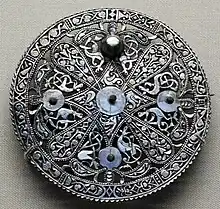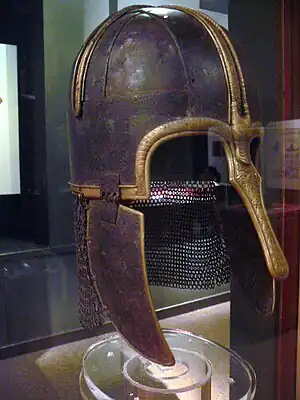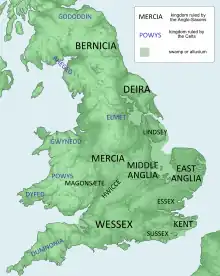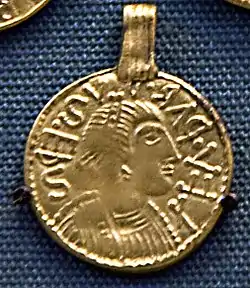Anglo-Saxon England
Anglo-Saxon England or Early Medieval England, existing from the 5th to the 11th centuries from soon after the end of Roman Britain until the Norman Conquest in 1066, consisted of various Anglo-Saxon kingdoms until 927, when it was united as the Kingdom of England by King Æthelstan (r. 927–939). It became part of the short-lived North Sea Empire of Cnut, a personal union between England, Denmark and Norway in the 11th century. The Anglo-Saxons migrated to Britain (Pretanī, Prydain) from mainland northwestern Europe after the Roman Empire withdrawal from the isle at the beginning of the 5th century. Anglo-Saxon history thus begins during the period of sub-Roman Britain following the end of Roman control, and traces the establishment of Anglo-Saxon kingdoms in the 5th and 6th centuries (conventionally identified as seven main kingdoms: Northumbria, Mercia, East Anglia, Essex, Kent, Sussex, and Wessex); their Christianisation during the 7th century; the threat of Viking invasions and Danish settlers; the gradual unification of England under the Wessex hegemony during the 9th and 10th centuries; and ending with the Norman Conquest of England by William the Conqueror in 1066. The Normans persecuted the Anglo-Saxons and overthrew their ruling class to substitute their own leaders for the purposes of overseeing and ruling England. However, Anglo-Saxon identity survived beyond the Norman Conquest, came to be known as Englishry under Norman rule, and through social and cultural integration with Romano-British Celts, Danes and Normans became the modern English people. (Full article...) Selected article
The Liudhard medalet is a gold Anglo-Saxon coin or small medal found some time before 1844 near St Martin's Church in Canterbury, England. It was part of the Canterbury-St Martin's hoard of six items. The coin, along with other items found with it, now resides in the World Museum Liverpool. Although some scholarly debate exists on whether or not all the items in the hoard were from the same grave, most historians who have studied the object feel that they were buried together as a necklace in a 6th century woman's grave. The coin is set in a mount so that it could be worn as jewellery, and has an inscription on the obverse or front surrounding a robed figure. The inscription refers to Liudhard, a bishop who accompanied Bertha to England when she married Æthelberht the king of Kent. The reverse side of the coin has a double-barred cross, or patriarchal cross, with more lettering. The coin was probably struck at Canterbury in the late 6th century, most likely between 578 and 589. Although it could have been used as a coin, it was more likely made as a medallion to proclaim the wearer's conversion to Christianity. The coin is the oldest surviving example of Anglo-Saxon coinage. The design of the figured side has some affinities with Merovingian and Visigothic coins, but the side with the cross has few known predecessors in coinage, and is the first northern European depiction of a patriarchal cross in any medium. (more...) Did you know? Did you know...
SubcategoriesCategory puzzle
 Anglo-Saxon England 5th century in England 6th century in England 7th century in England 8th century in England 9th century in England 10th century in England Anglo-Saxon literature Anglo-Saxon archaeology Anglo-Saxon art Christianity in Anglo-Saxon England Conflict in Anglo-Saxon England 11th century in England Fiction set in Anglo-Saxon England Hen Ogledd Anglo-Saxon kingdoms Anglo-Norse England Old English Anglo-Saxon paganism Anglo-Saxon people Peoples of Anglo-Saxon England Anglo-Saxon studies scholars Anglo-Saxon settlements Anglo-Saxon society Selected image Anglo-Saxon Coppergate Helmet The 8th century Anglo-Saxon Coppergate Helmet Selected biography
Sweyn I Forkbeard (Old Norse: Sveinn Tjúguskegg; c. 960 − 3 February 1014) was king of Denmark and England, as well as parts of Norway. His name appears as Swegen in the Anglo-Saxon Chronicle. He was a Viking leader and the father of Cnut the Great. On his father Harald Bluetooth's death in late 986 or early 987, he became King of Denmark; in 1000, with allegiance of the Trondejarl, Eric of Lade, he was ruler over most of Norway. After a long effort at conquest, and shortly before his death, in 1013 he became the first of the Danish Kings of England. (more...) Things you can do
Featured articles and lists
Related portalsWikiProjects
Associated WikimediaThe following Wikimedia Foundation sister projects provide more on this subject:
| |||||||||||||||||||



